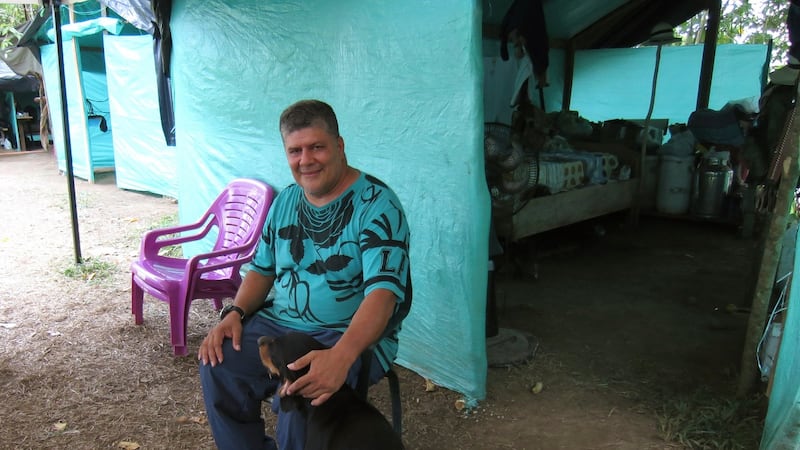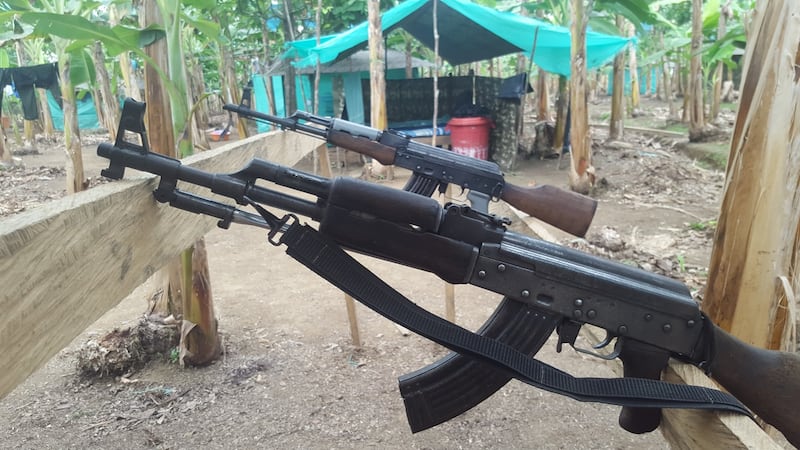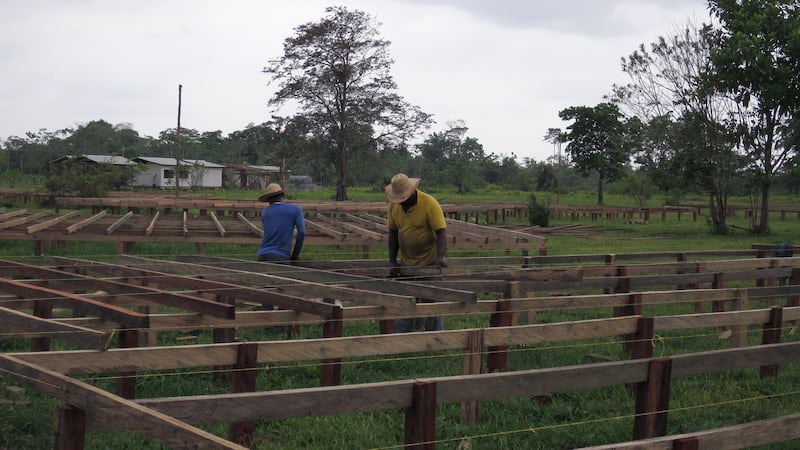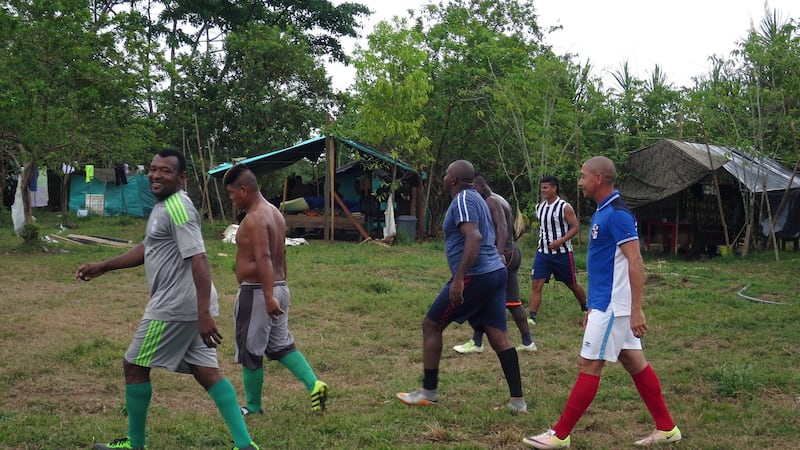In a small clearing in a seemingly endless jungle of plantain trees, two austere, uniformed men sit with assault rifles in their laps. Cloud cover has diluted the fierceness of the day’s heat – we are only about 1,000km north of the equator – and the ensuing slow-bake is more apt and more merciful for monotonous hours of guard duty. This is a land of jungle greens and dusty browns, which makes the yellow, blue and red band worn high on one man’s arm so eye-catching that the capitalised “FARC” printed on it seems redundant.
You might guess that this is territory in the control of the Fuerzas Armadas Revolucionarias de Colombia (Revolutionary Armed Forces of Colombia), but that is not quite true. After 52 years of war, this encampment at Florida, in the poor northwestern Chocó department – the name for a state in Colombia – is one of 26 zones across the country where the insurgents have come to hand in their weapons to the United Nations. Here, 160 fighters from the Farc's 57th Front are waiting in a temporary camp, which they built in a day, not only to demobilise, but for the camp proper to be built.
"We have a saying in Colombia," Farc commander Pablo Atrato says drily. "If this is the way the breakfast is, what will lunch be like?"
For weeks, the lack of preparation in the transition zones convulsed media in the country, gave the government a headache, and sapped the confidence of guerrillas waiting to disarm. “We think the delay in building the camps is to make the guerrillas think: ‘This isn’t going to to work out, this isn’t worth it’,” says Olmedo Ruiz, another commander.

The front arrived at Florida on January 31st after a difficult day's march. ("That's a whole different story," says Natalie Mistral, a nom de guerre for the front's French-born guerrilla.) At this moment – early March – there are workmen still fiddling at the wooden skeleton of outhouses in the first phase of construction as guerrillas play a football match of wild, thunderous challenges on a rutted pitch beside them.
An official at one UN agency expresses disbelief that, after four years of peace talks in Havana, the Colombian government could not build 26 camps for 7,000 guerrillas in the two months after a revised peace deal was ratified in congress at the end of November. The government blamed delays on difficult terrain in the many remote areas where the camps are based, but the logistical backlog has added further pressure to a process already working against the clock.
Under the terms of the peace agreement, the guerrillas are scheduled to leave the camps, fully disarmed, by May 31st – a timetable which Eamon Gilmore, the European Union's special envoy to Colombia, calls "very ambitious". "If that succeeds, it means the disarmament stage of the peace process will have been completed within six months. It took Northern Ireland seven years for the decommissioning of weapons to take place," says Gilmore. The "rush" is unnecessary, says Mistral: "We feel as though they're only interested in us giving up the weapons. And what we negotiated in Havana is about far more than that."
Nonetheless, for the guerrillas in the 57th Front, life has already entered a new phase. Through uncertain months from when the first peace deal with the government was agreed last August, to its stunning rejection in an October 2nd plebiscite and beyond, the guerrillas have been preparing for a life more ordinary.

Mistral, from Burgundy, who joined the group in search of “change” at the age of 22, says that for guerrillas used to moving camp once a week, putting down roots in the transition zone “doesn’t feel weird – but you do think: ‘It’s been a long time here’.” (The rebels are not allowed to leave the zones without permission.) Five of the women in the 57th Front are pregnant, looking forward to futures nursing children rather than AK-47s. Newly acquired pet rabbits can be seen, noses twitching, alongside military boots at the bottom of one rebel’s bunk.
“It’s funny, because we’ve started having a new state of mind, wanting different things – like having a pet. Before, the pets were the animals from the jungle,” says Mistral, the front’s media officer and the partner of Atrato, the commander. “I believe everybody thinks it’s not possible that the agreement is not going to work. It is going to work. All those ideas of getting back with their families are set in their minds.”
Their biggest concerns lie not only in the late construction of the camp, the delay in releasing Farc prisoners under an amnesty, and the slow start to re-education commitments agreed in the peace deal – issues that will encourage dissidency – but also in the psychological burden of leaving the jungle and joining society. Ruiz, a commander of 30 years who joined the Farc at 16, says: “We’ve got to get used to this new life. I have created so many habits in the jungle. We’re used to living in a group community – maybe I’m going to feel defenceless because we won’t be together. The way we live here builds confidence. I’m going to miss that a lot.”
War in many parts
Is Colombia’s war finally over? It seems there is scarcely anyone in the country, including the peace deal’s opponents, who does not regard the decommissioning of the Farc as a positive, but there is no easy transition to peace at the end of a conflict with a complexity to match its longevity.
"I think if you talk about the Farc, the Farc will probably disappear," says Jozef Mercx, Colombia representative for the UNHCR, the UN's refugee agency. "For me it's very unlikely that the demobilisation will fail. I think it will happen – but then we might get other phenomena." In Colombia's conflict there have always been other phenomena – turning what began, notionally, in 1964 as an uprising of 48 armed peasants with its roots in "La Violencia", the bloody civil war of 1946-1958, into a multifaceted, intractable war.
Basta Ya! (Enough Already!), a 400+ page official report by the Centro Nacional de Memoria Histórica, a public institution that records acts of violence in the conflict, makes it clear that Colombia's war has had several distinct phases and a multiplicity of actors. The period 1982-1996 brought developments that resonated globally: the military growth of the guerrilla groups, the emergence of paramilitaries, the partial collapse of the state, and the irruption and spread of drug-trafficking.

In the next phase (1996-2005), guerrillas and paramilitaries expanded (by 1998, the Farc was estimated to have 18,000 fighters), and public opinion was radicalised to seek a military solution to the conflict. At this time, too, the global war on terror and drug trafficking was brought to Colombia, especially through the US-backed Plan Colombia, which further fuelled the armed conflict.
The final phase (2005-2012) saw the state's counterinsurgency tactics succeed in weakening but not defeating the guerrillas. At the same time, efforts under former president Álvaro Uribe (now the opposition leader, and a fierce opponent of the peace deal) to decommission the paramilitaries of United Self-Defence Forces of Colombia (Autodefensas Unidas de Colombia, or AUC), a coalition of right-wing death squads that colluded with the state and were also associated with the world of drug kingpin Pablo Escobar, ended in failure.
Many of these fighters never demobilised; instead they formed new armed groups (now referred to as “criminal bands” or “Bacrims”, from the Spanish acronym – though many still call them paramilitaries) which are fractured, volatile, highly active, and one of the biggest threats to the country’s peace. Many continue to battle for control of illegal economies such as coca crops and mining, or to oppose land restitution – threatening or killing those who get in their way.

The terrible statistics of the conflict compiled by the Centro Nacional de Memoria Histórica make it clear that, in a complex war, there is plenty of blame to go around. Between 1958 and 2012, the conflict led to the deaths of 220,000 people at the hands of guerrillas, paramilitaries and state actors. Broadly speaking, paramilitaries specialised in massacres; the Farc in kidnappings.
Of 1,982 recorded massacres (the killing of four or more people in a defenceless state) carried out between 1980 and 2012, paramilitaries were responsible for 58.9 per cent; guerrillas 17.3 per cent; security forces 7.9 per cent; and unidentified armed groups 14.8 per cent. Of the 27,023 kidnappings reported between 1970 and 2010, guerrilla groups were responsible for 90.6 per cent, with paramilitaries carrying out 9.4 per cent.
The turmoil caused by the conflict can be measured in other ways: according to the UNHCR, there are more than seven million "internally displaced persons" in Colombia – outside of Syria, the largest number of IDPs in the world.
It is no wonder, then, that every recent presidential election in Colombia has been dominated by one theme: how to put an end to it.
Towards peace
There have been several failed attempts at a peace deal with the Farc, and the low-intensity conflict of the last decade offered another opening. The guerrillas were badly weakened and voters had finally, conclusively had enough of war, on all sides.

"The peace process in a way was a negotiation on the futility of violence," says Jorge Restrepo, an analyst at Cerac, a leading research centre on the conflict. Yet when talks began in Havana in 2012 with no ceasefire in place, the war rumbled on back home. "And actually that proved to be unsustainable," says Restrepo. (The Farc went on to initiate a unilateral ceasefire in July 2015).
“Public opinion was instrumental in getting the Farc to stop violent actions: first kidnapping, then what we call here terrorist actions, actions against civilian targets or the military and then later on targets of infrastructure,” Restrepo adds. “Public opinion also rejected the cases in which military force was used against the Farc. They accepted, for example, that the government stop using aerial bombardments against Farc targets. And in a way that process of de-escalation got hold in Colombian public opinion. And I think that will be one of the most important safeguards against a return to an open confrontation.”
What emerged from four years of talks in Havana was a 297-page agreement dealing with many issues that arose in Northern Ireland, as well as others unique to the far larger, more complex situation in Colombia: a transitional justice mechanism; amnesties for political prisoners; decommissioning; a political option for the Farc; justice and reparations for victims; demining; coca crop substitution; rural and land reform.
Opinion polls indicated it would easily pass when put to referendum last October, but the agreement's opponents had led an effective campaign that convinced many voters that the guerrillas were, literally, getting away with murder. On a low turnout of 38 per cent (partly apathy or disillusionment, although there was also a hurricane in the Caribbean region that day), the agreement was rejected by 55,651 votes (50.2 per cent to 48.8 per cent), a result so unexpected that Colombia's president, Juan Manuel Santos – the instigator and champion of the peace process – had held a lavish signing ceremony with the Farc leader Rodrigo Londoño ("Timochenko") in Cartagena a week before the vote.

“It [the referendum] showed not only that the country was split down the middle, but also that the distance in the positions and preferences of the electorate was huge,” says Restrepo. “There is a perfect polarisation in this country in terms of how to stop the conflict.”
The rejection of the deal was a terrible blow, but the government and the Farc moved swiftly to renegotiate and address many concerns, in areas such as victim reparations and restrictions on liberty for convicted combatants. In less than two months a new agreement, 13 pages longer, was unveiled – and this time, to the outrage of the opposition, ratified in congress, where the government holds a majority.
The government’s calculation was that further debate, or another referendum, would torpedo the entire process. Nonetheless, with presidential and parliamentary elections next year, Santos’s strategy could not be said to have categorically secured peace; but it has bought time.
A report published in January by the International Crisis Group, a non-profit NGO specialising in conflict research, underlines the importance of a swift, effective implementation of the peace deal – in areas such as rural development programmes, coca crop substitution, decommissioning and reintegration of fighters – and highlights the dangers of an opposition leader entering power.
Restrepo agrees that, although he does not envisage a return to open conflict between the government and the Farc, the great threat is swapping an administration favourable to the agreement for one implacably opposed: “They can repeal the agreements – it would be difficult, but definitely they can do so. In my view that’s the high risk that the agreements face.”

The other great challenge is rooted in Colombia's deeply unequal and peculiarly polarised society, which is partly due to the decentralising effect of the country's mountain-and-jungle topography. Citizens of Bogotá can fly to Miami in less than half the time it takes to reach many of the country's more far-flung and poorly developed regions by plane, boat and pick-up truck.
These are the regions that have been in the eye of the storm in Colombia for more than 50 years – territories long forgotten by the capital, lacking basic infrastructure and an institutional state presence, and now abandoned by disarming guerrillas. In these areas people fear that, as one armed group leaves, another will soon arrive to take its place. In some places that has already happened.
New killings
The car winds in the direction of the Peace Community of San José de Apartadó, located high along a country road a few miles from the city of Apartadó, in the Urabá region of Antioquia. Few regions in Colombia have been in the firing line as much as Urabá, which has witnessed many massacres as well as being a hub of paramilitary expansion in the 1990s.
Urabá is resource rich, the home of Colombia's banana trade, and its border with Panama and its Caribbean coastline put it at the heart of the narco-trafficking industry. The missing link in the Pan-American Highway, known as the Darién Gap, is located here, existing as a peculiar tribute to the harsh terrain of the region's more remote areas.
In late March, the Peace Community of San José de Apartadó marked 20 years since it was founded as a collective response to the killings and forced displacements in the region. Its aims as a neutral and peaceful community, made up of 10 scattered villages, have not kept it safe, however. Since its founding, more than 300 members have been killed or forcibly displaced from their homes, according to Amnesty International, including two emblematic massacres carried out by paramilitaries in 2000 and 2005 in which 14 people were killed.
In the village of La Holandita, which is home to about 100 people, there is little optimism around the peace deal with the Farc. One community leader, who does not wish to be named, lays out the stark reality for some people living a long way from the parliamentary chambers of Bogotá: “The peace process is supposed to be the end of a war between the state and Farc. It’s one less group, so that’s a good thing. But the problem is that Farc is not the only armed group in the area. Farc right now are in the zones, so now the paramilitaries came back to take over all the area. So nothing changes – just one armed group left and another came.
"The paramilitaries have made threats, they have killed no members of our community, but [they have killed] other people in the area. The paramilitaries sexually assaulted a woman a few weeks ago and they're saying that they are here to stay. They say they're going to stay here whether we like it or not. They say that now the Farc are not here they're going to dominate the territory."
There is no more pressing question in Colombia than how to secure those areas where the Farc has left. In early April, the head of the UN Mission to the country, Jean Arnault, told the United Nations Security Council that the Colombian military had been "slow" and "inefficient" in assuming control of former Farc territories.
Since last year, attacks on civil society leaders in the country have increased, with 80 social leaders killed in 2016 (a rise of 22 per cent), according to Somos Defensores, an NGO that works for the protection of human rights defenders. Targeted assassinations – of union leaders, land restitution campaigners and other activists – have continued into 2017.
“If the government is not able to fill the gaps left behind by the Farc, then there’s still a possibility of more displacement, more killings of community leaders,” says Mercx of the UNHCR. “Many people here have this positive image that once the peace deal was signed, that everything has been solved, but it’s not that easy and the government knows it as well. There is a need to go to these municipalities and those demobilisation areas, to really bring development to those areas – otherwise you will still allow the illegal economies to flourish and others will still benefit from it.”
For Carlos Guevara of Somos Defensores, the killing of social leaders has a fundamental impact on the ability of the country to leave the war behind once and for all. "Every time a leader or a defender is killed in the country they are killing the hopes of the community for getting out of the problems. They are sending a message to those communities that peace isn't possible," he says, suggesting that only the institutional presence of the state can deal with the issue. "People think the presence of the state is the presence of the army and that's not true. State presence is health, education, justice, food – not only battalions. Battalions or armed soldiers don't deal with the problems of our society."
If these issues are not addressed urgently, Guevara says, the prospects for peace are bleak. “If this violence continues for another year people will become armed again. Different people, but also people that are in Farc that see that nothing is changing, because that has happened before in Colombia. The war in Colombia has been absent from the cities. If people arm again the war will go to the cities and we will go back years and lose everything that we’ve done.”
* First article in a series of four. Monday: The Farc guerrilla.

* This article is supported by a grant from the Simon Cumbers Media Fund


















